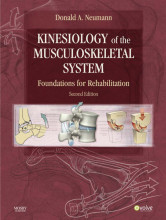Getting started
26 important questions on Getting started
Which to perspectives do you have considering a joint?
- The proximal segment can rotate against the relatively fixed distal segment.(closed chain)
- The distal segment can rotate against the relatively fixed proximal segment.(open chain)
What is stance phase?
What is swing phase?
- Higher grades + faster learning
- Never study anything twice
- 100% sure, 100% understanding
What is an closed 'kinematic' chain?
What are the three fundamental movements?
- roll
- slide
- spin
What are the arthokinematics principles of movement?
- By a convex-on-concave surface movement the convex member slides en rolls in the opposite direction.
- By a concave-on-convex surface movement the concave member rolls and slides int the similar direction.
What is a close-packed position?
What is the maximal loose-packed position?
What is the ultimate failure point and when does this occur?
What is the moment arm (lever arm)?
Which two outcomes have a force exerted on the body?
- Translation of a body segment
- Rotation of a joint
What is static linear equilibrium?
What is the angle-of-insertion?
What are the four factors making a force vector?
- Magnitude
- Spatial orientation
- Direction
- Point of application
What are internal forces?
What are external forces?
What is magnitude of force vectors?
What is the direction of the force vector?
What is line of force or/and line of gravity?
What is the point of application in a force vector?
What is static rotatory equilibrium?
What is isometric activation?
What is eccentric activation?
What is a synergists?
What is a muscular force-couple?
What are the three lever-classes?
- The first lever-class is when the internal and external forces typically act in similar linear directions, but they produce torques in the opposite rotary direction, like your head-neck.
- The second-class lever has its axis of rotation located at one end of the bone, while the muscle or internal force possesses a greater leverage than the external force.
- The third-class lever Has also the axis of rotation located at the end of the bone. The external weight always has a greater leverage than the muscle force.
The question on the page originate from the summary of the following study material:
- A unique study and practice tool
- Never study anything twice again
- Get the grades you hope for
- 100% sure, 100% understanding
































